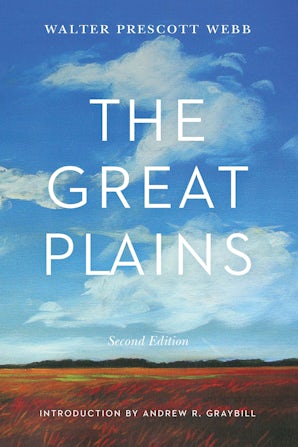About the Book
Published in Cooperation with the William P. Clements Center for Southwest Studies, Southern Methodist University
This iconic description of the interaction between the vast central plains of the continent and the white Americans who moved there in the mid-nineteenth century has endured as one of the most influential, widely known, and controversial works in western history since its first publication in 1931. Arguing that “the Great Plains environment . . . constitutes a geographic unity whose influences have been so powerful as to put a characteristic mark upon everything that survives within its borders,” Walter Prescott Webb identifies the revolver, barbed wire, and the windmill as technological adaptations that facilitated Anglo conquest of the arid, treeless region. Webb draws on history, anthropology, geography, demographics, climatology, and economics in arguing that the 98th Meridian constitutes an institutional fault line at which “practically every institution that was carried across it was either broken and remade or else greatly altered.”
This new edition of one of the foundational works of western American history features an introduction by Great Plains historian Andrew R. Graybill and a new index and updated design.
Author Bio
Walter Prescott Webb (1888–1963) was among the most important and influential historians of the American West. He spent his career at the University of Texas and enjoyed visiting appointments in London and Oxford. Webb was the author of a number of highly provocative books, including The Texas Rangers and The Great Frontier. Andrew R. Graybill is a professor of history and director of the William P. Clements Center for Southwest Studies at Southern Methodist University. He is the author or editor of four books, including Policing the Great Plains: Rangers, Mounties, and the North American Frontier, 1875–1910 (Nebraska, 2007).
Praise
"The Great Plains is not simply a celebration of settlers overcoming obstacles, but also a rendering of the devil's bargains that went into establishing only partial and often impermanent solutions amid relentless aridity. Readers can choose to find the humility in that kind of history, and the lessons that come with it have only grown more relevant with time."—Mark Boxell, Nebraska History
“Walter Webb’s The Great Plains wrenched our understanding of the West—and through that, of American history—onto a strikingly new course. Engaging and fluently written, it remains largely as pertinent today as when it appeared nearly a century ago. Andrew Graybill’s smart and balanced introduction is the ideal guide to how we can begin to learn from both the insights and the flaws of this American classic.”—Elliott West, Alumni Distinguished Professor of History at the University of Arkansas
Table of Contents
Introduction
Andrew R. Graybill
Preface
1. Introduction
2. The Physical Basis of the Great Plains Environment
1. How the Great Plains Were Built
2. The Climate of the Great Plains
3. The Plant Life of the Great Plains
4. Animal Life on the Great Plains
3. The Plains Indians
1. Characteristics of the Plains Indians
2. The Spread and Use of the Horse among the Plains Indians
3. Horsemanship and Weapons
4. The Sign Language of the Plains Indians
4. The Spanish Approach to the Great Plains
1. The Spanish Colonial System Unsuited to the Great Plains
2. The Spanish Explorers on the Plains: A Period of Success
3. The Spanish Colonial Period: The Beginning of Failure
5. The American Approach to the Great Plains
1. Exploring the Great Plains: Marking the Trails
2. Creating the Tradition of the “Great American Desert”
3. The Texas Approach to the Great Plains: The Texans Touch the Plains
4. The Great Plains Block the Expansion of the South
6. The Cattle Kingdom
1. The Origin of the Kingdom
2. The Spread of the Kingdom
3. The Evolution of the Range and Ranch Cattle Industry, 1866–1928
4. The Ways of Life on the Cattle Range
5. The Twin Spectacles of the Range: the Roundup and the Drive
7. Transportation and Fencing
1. Railroads in the Great Plains
2. The Fence Problem
8. The Search for Water in the Great Plains
1. The Available Supply of Moisture in the Great Plains
2. Well-Making and Windmills
3. Irrigation in the Great Plains
4. Dry Farming: Conservation of Soil Moisture
5. Some Vagaries of the Search for Water
9. New Laws for Land and Water
1. Enlarging the Land Unit
2. The Development of the Land Law for the West
3. Development of the Western Water Laws
10. The Literature of the Great Plains and About the Great Plains
1. The Literature of the Frontier and the Cattle Kingdom
2. The Literature of the Farm
11. The Mysteries of the Great Plains in American Life
1. What Immediate Effects Did the Great Plains Have Upon the Anglo-American?
2. Did Man Originate on the Plains or in the Forest?
3. Why Is the West Considered Spectacular and Romantic?
4. Why Was the West Considered Lawless? Was It Really Lawless or Did It Merely Appear Lawless?
5. Why Is the West Politically Radical?
6. What Has Been the Spiritual Effect of the American Adventure in the Great Plains on Women?
7. In Conclusion: Let Us Inquire What Has Been and What Is to Be the Meaning of the Great Plains in American Life
Notes
Bibliography
Index
